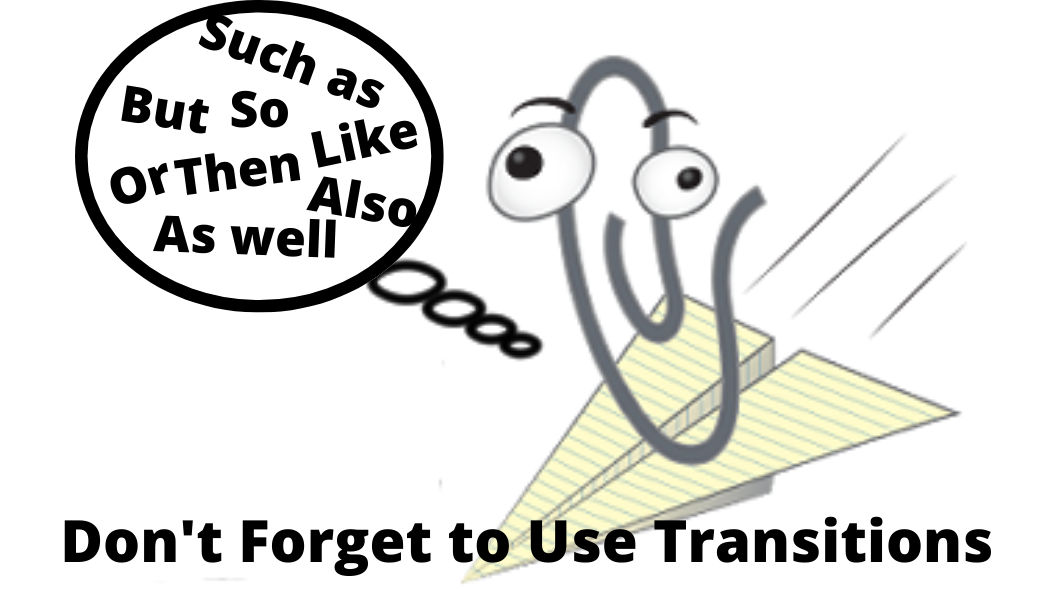Transition words help link two sentences or paragraphs together by providing context that helps readers link the information. They also provide organization and structure to a piece,making it easier to read and understand. Words and phrases such as, similarly, furthermore, in order to and as a result help to show the relationship between your ideas and illustrate contrast, agreement and show cause and effect.
Often, we don’t even notice transition words, but they help ensure the writing isn’t dry and minimizes the risk of abrupt changes from one sentence or paragraph to the next. There are many different types of transition words and phrases, many of which impact readability and SEO.
How Transition Words Impact SEO
Including transition words in a piece helps to improve readability, and if text is easier to read, more people are going to find it engaging. This means visitors will spend more time on the page, which is something search engines consider when determining page rankings.
The Types of Transition Words
There are literally hundreds, if not thousands of transition words you could use. There’s also a few types of transition words such as those that show addition, clarification, similarity and contrast. Such as:
Addition
Some of the most commonly used types of transition words. Addition transitions are used to reinforce or expand upon certain points we are making. Some commonly used addition transitions include:
- Also
- Again
- In addition to
- Like
- Not to mention
- And
- Too
- As
While these are the most commonly used, there are other options that work just as well, and help you avoid repetition. When writing, think about the transition words you’ve used and try to find alternatives such as moreover or equally.
Cause and Effect
We all know that every action has a reaction, and there’s plenty of transition words to show that. Some of the most commonly used include:
- Whenever
- If
- Due to
- Because
- So long as
Clarification
Often, a good way to get a point across is to give an example, and clarification transitions help you point out specific situations, items and people. Clarification transitions include words and phrases such as:
- Namely
- For example
- In other words
- Such as
- In particular
Contrast
While they may seem negative, contrast transitions can help introduce topic shifts and highlight important differences between ideas in your writing. Popular options include:
- Although
- But
- Despite
- Instead of
- Besides
Similarity/Emphasis
Similarity or emphasis transitions help you connect closely related phrases and ideas. Examples include:
- In the same way
- Likewise
- As well as
- Especially
- To say nothing of
Enumeration
These transitions include all the phrases that show a chronological sequence in a piece. Examples include:
- Firstly
- First of all
- To begin with
- Secondly
- Lastly
- Finally
Enumeration transitions work best at the beginning of a sentence or paragraph, and work really well when writing how to type articles.
Time
Time transitions can be very useful, especially when writing blogs or buying guides. They are essential when trying to show a series of events and there’s plenty of options to pick from. Some of the most commonly used include:
- Formerly
- Afterward
- Meanwhile
- Eventually
- At the same time
Space
References to space are more common in writing than you’d think. So, there’s a wide range of transition words to choose from. Including:
- There
- Here
- Before
- After
- Where
Details
Detail transitions help to emphasize a point or idea. Popular options include:
- To explain
- In particular
- Specifically
- Including
- Namely
Summary
In many types of writing, it’s a good idea to provide a recap of the important points. To do that, summary transitions are an ideal option. Here are a few examples:
- Finally
- Therefore
- In short
- In conclusion
- As a result
As you can see, there’s definitely a place for transition words and phrases in most types of writing, both to make the piece easier to read and understand and to improve SEO. This article has plenty of examples. However, there are many more options available. If you use a grammar checker (and you should), most will have a transition checker to help ensure you’ve used them where necessary and that you’ve used the right ones.
Do’s and Don’ts
Transition words help improve your writing. However, overusing them can be detrimental to the piece and to SEO rankings. So, follow these tips.
Do
- Use transitions when you’re introducing a new idea
- Use a different transition word for each idea to avoid repetition
- Read through what you’ve write before submitting to ensure it makes sense
- Consider creating an outline of your ideas so you can understand how to use transitions correctly
Do Not
- Use too many transitions – it can make your writing repetitive and boring
- Depend on transition words to show relationships between ideas – the words or phrases alone are not enough
- Use transitions in every sentence – make sure they are spaced out evenly throughout the piece
Of course, every article and grammar tip we post is a general guideline and occasionally we come across a client that may want us to do something differently. So, it’s imperative that you read and fully understand the creative brief for every project before you start working.

